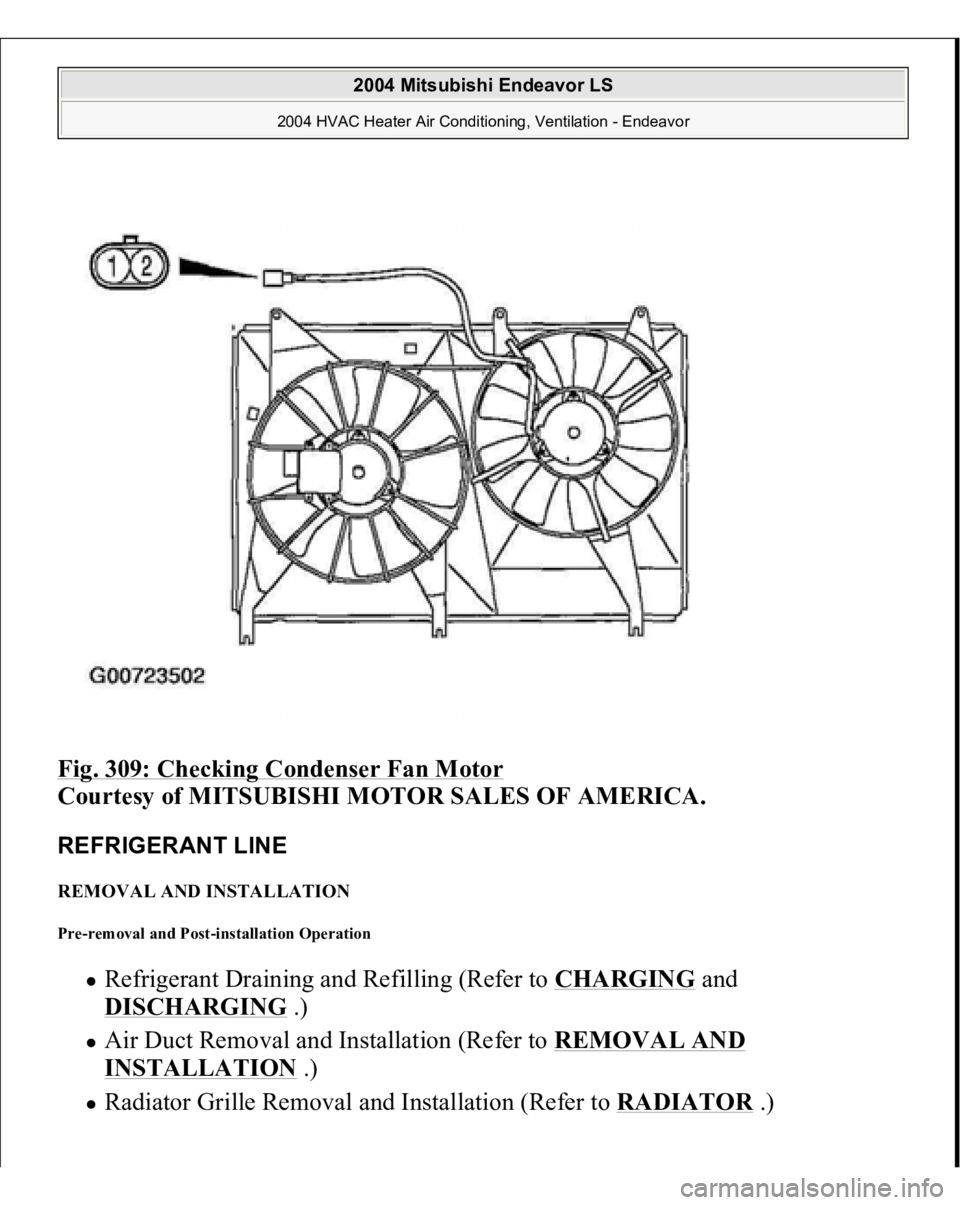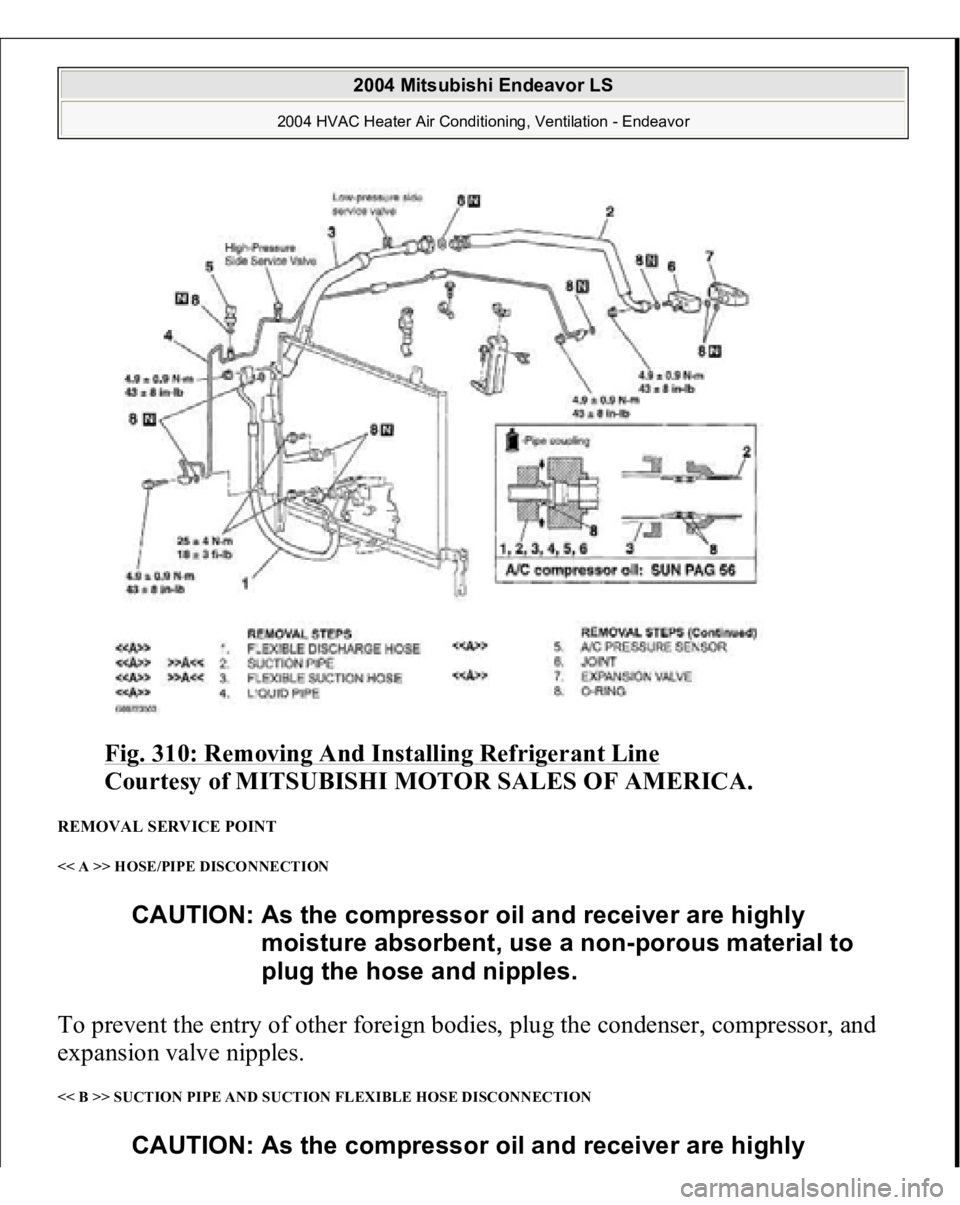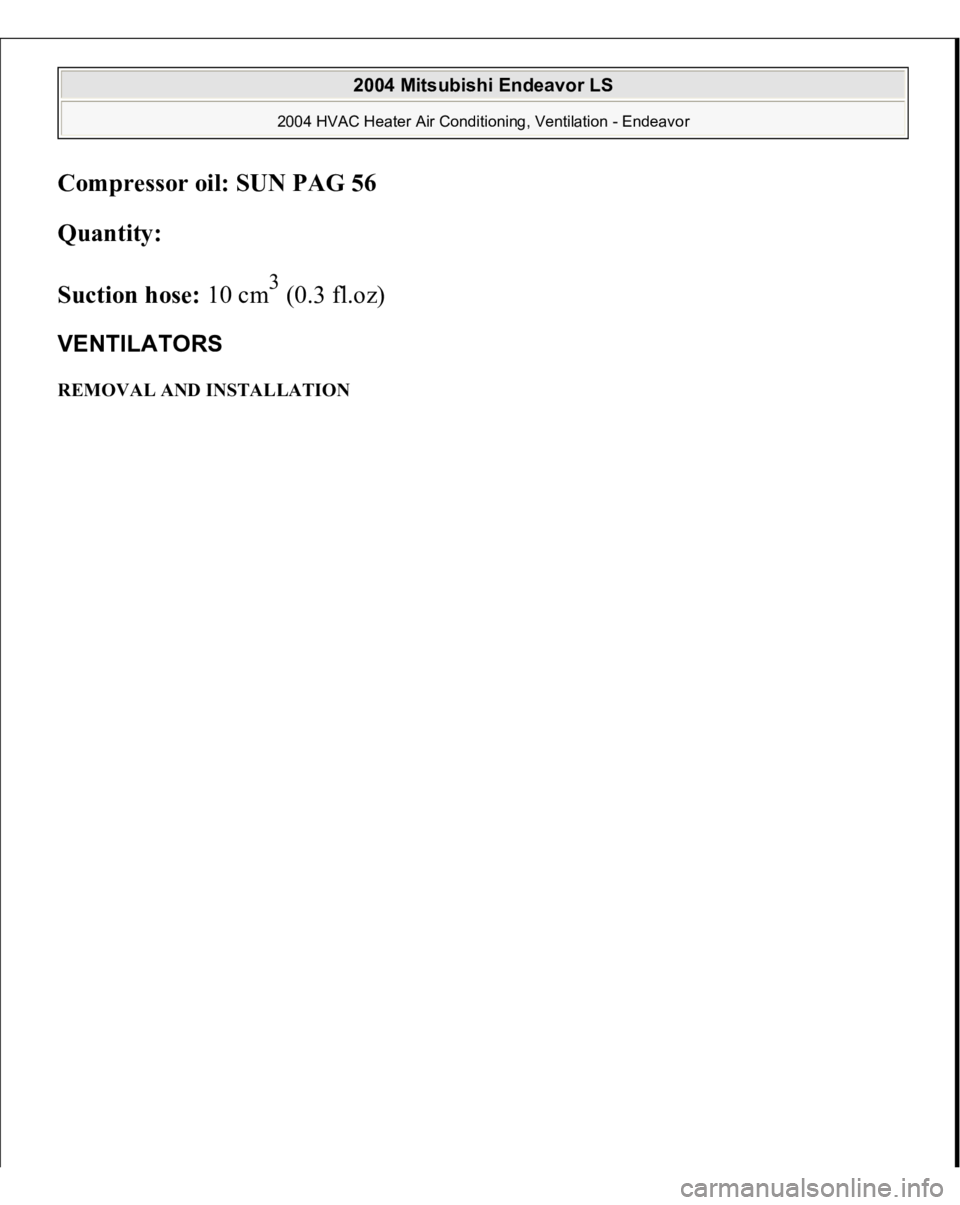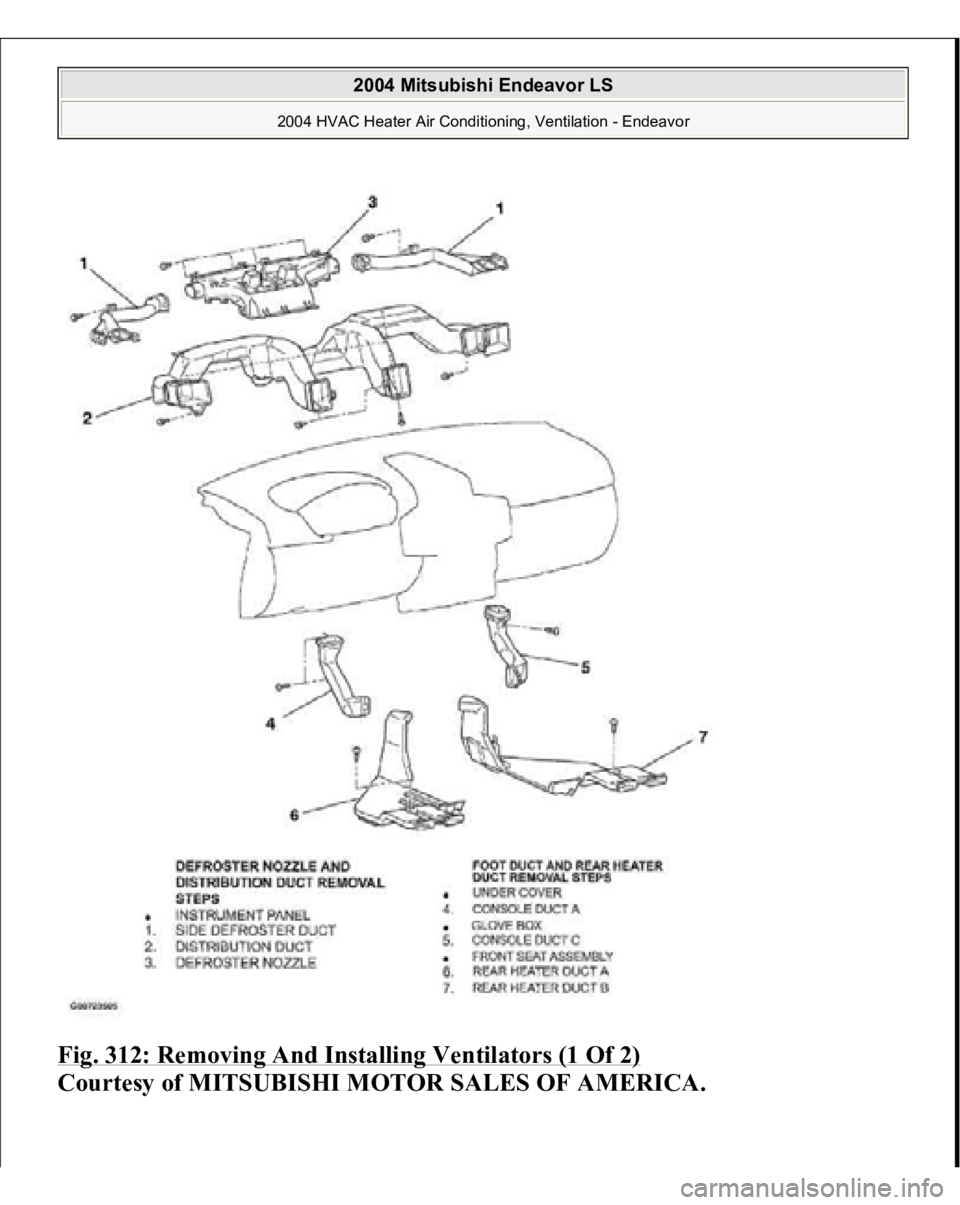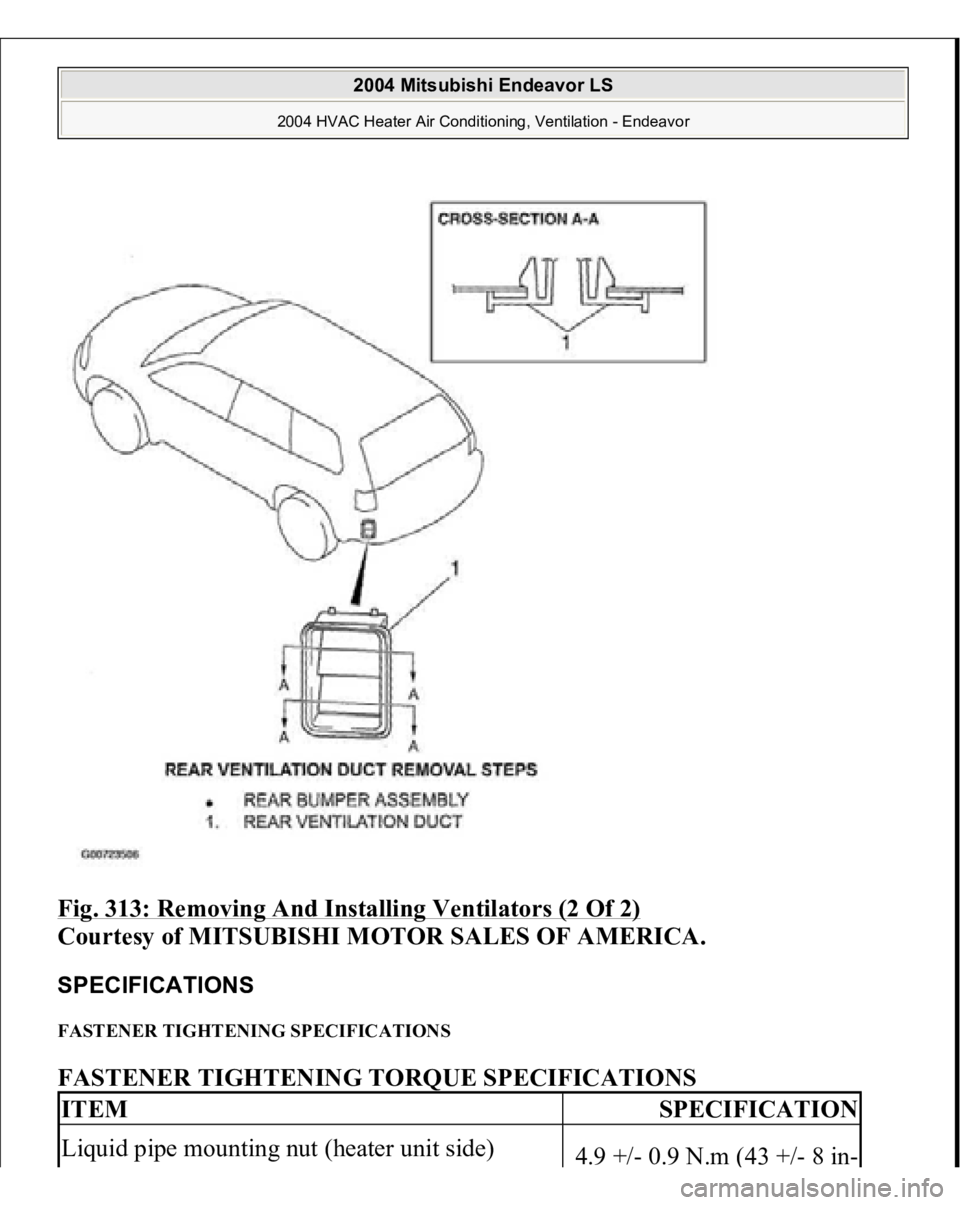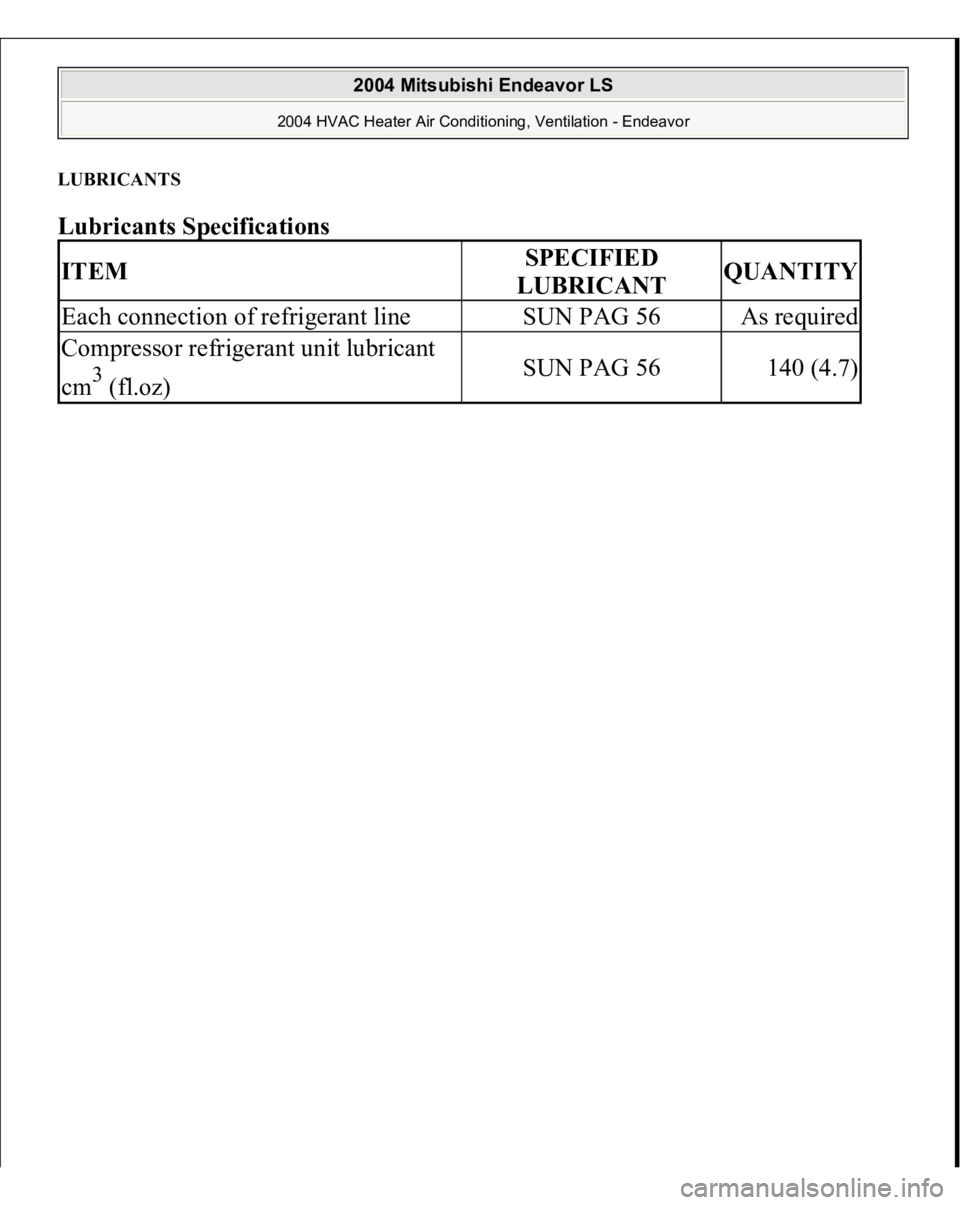MITSUBISHI ENDEAVOR 2004 Service Repair Manual
ENDEAVOR 2004
MITSUBISHI
MITSUBISHI
https://www.carmanualsonline.info/img/19/57105/w960_57105-0.png
MITSUBISHI ENDEAVOR 2004 Service Repair Manual
Trending: engine gasket, turn signal, engine oil, fluid, turn signal bulb, TROUBLESHOOTING - COMMUNICATION ERROR ON DISPLAY, tire pressure
Page 2411 of 3870
Fig. 309: Checking Condenser Fan Motor
Courtesy of MITSUBISHI MOTOR SALES OF AMERICA.
REFRIGERANT LINE REMOVAL AND INSTALLATION Pre-removal and Post-installation Operation
Refrigerant Draining and Refilling (Refer to
CHARGING
and
DISCHARGING
.)
Air Duct Removal and Installation (Refer to
REMOVAL AND
INSTALLATION
.)
Radiator Grille Removal and Installation (Refer to
RADIATOR
.)
2004 Mitsubishi Endeavor LS
2004 HVAC Heater Air Conditioning, Ventilation - Endeavor
Page 2412 of 3870
Fig. 310: Removing And Installing Refrigerant Line
Courtesy of MITSUBISHI MOTOR SALES OF AMERICA.
REMOVAL SERVICE POINT << A >> HOSE/PIPE DISCONNECTION To prevent the entry of other foreign bodies, plug the condenser, compressor, and
expansion valve nipples. << B >> SUCTION PIPE AND SUCTION FLEXIBLE HOSE DISCONNECTION
CAUTION: As the compressor oil and receiver are highly
moisture absorbent, use a non-porous material to
plug the hose and nipples.
CAUTION: As the compressor oil and receiver are highly
2004 Mitsubishi Endeavor LS
2004 HVAC Heater Air Conditioning, Ventilation - Endeavor
Page 2413 of 3870
To disconnect the suction hose from the suction flexible hose, lift the lug on the
suction pipe and twist the suction flexible hose union counterclockwise.
Plug the hose nipple to prevent entry of dust and dirt. Fig. 311: Disconnecting Suction Pipe
Courtesy of MITSUBISHI MOTOR SALES OF AMERICA.
INSTALLATION SERVICE POINT >> A << SUCTION HOSE INSTALLATION When replacing the suction hose, refill them with a specified amount of compressor
oil, and then install them.
moisture absorbent, use a non-porous material to
plug the hose and nipples.
2004 Mitsubishi Endeavor LS
2004 HVAC Heater Air Conditioning, Ventilation - Endeavor
Page 2414 of 3870
Compressor oil: SUN PAG 56
Quantity:
Suction hose:
10 cm
3 (0.3 fl.oz)
VENTILATORS REMOVAL AND INSTALLATION
2004 Mitsubishi Endeavor LS
2004 HVAC Heater Air Conditioning, Ventilation - Endeavor
Page 2415 of 3870
Fig. 312: Removing And Installing Ventilators (1 Of 2)
Courtesy of MITSUBISHI MOTOR SALES OF AMERICA.
2004 Mitsubishi Endeavor LS
2004 HVAC Heater Air Conditioning, Ventilation - Endeavor
Page 2416 of 3870
Fig. 313: Removing And Installing Ventilators (2 Of 2)
Courtesy of MITSUBISHI MOTOR SALES OF AMERICA.
SPECIFICATIONS FASTENER TIGHTENING SPECIFICATIONS FASTENER TIGHTENING TORQUE SPECIFICATIONS
ITEM
SPECIFICATION
Liquid pipe mounting nut (heater unit side)
4.9 +/- 0.9 N.m
(43 +/- 8 in-
2004 Mitsubishi Endeavor LS
2004 HVAC Heater Air Conditioning, Ventilation - Endeavor
Page 2417 of 3870
GENERAL SPECIFICATIONS Fig. 314: General Specifications Chart
Courtesy of MITSUBISHI MOTOR SALES OF AMERICA.
SERVICE SPECIFICATIONS Fig. 315: Service Specifications Chart
Courtes
y of MITSUBISHI MOTOR SALES OF AMERICA
.
lb)
Liquid pipe mounting bolt (condenser side)
4.9 +/- 0.9 N.m (44 +/- 8 in-
lb)
Suction flexible hose mounting nut (compressor
side)
25 +/- 4 N.m (18 +/- 3ft-lb)
Suction pipe mounting nut (heater unit side)
4.9 +/- 0.9 N.m (43 +/- 8 in-
lb)
Discharge flexible hose mounting bolt
(compressor side)
25 +/- 4 N.m (18 +/- 3 ft-lb)
Discharge flexible hose mounting nut (condenser
side)
4.9 +/- 0.9 N.m (43 +/- 8 in-
lb)
2004 Mitsubishi Endeavor LS
2004 HVAC Heater Air Conditioning, Ventilation - Endeavor
Page 2418 of 3870
LUBRICANTS Lubricants Specifications
ITEM
SPECIFIED
LUBRICANT
QUANTITY
Each connection of refrigerant line
SUN PAG 56
As required
Compressor refrigerant unit lubricant
cm
3 (fl.oz)
SUN PAG 56
140 (4.7)
2004 Mitsubishi Endeavor LS
2004 HVAC Heater Air Conditioning, Ventilation - Endeavor
Page 2419 of 3870
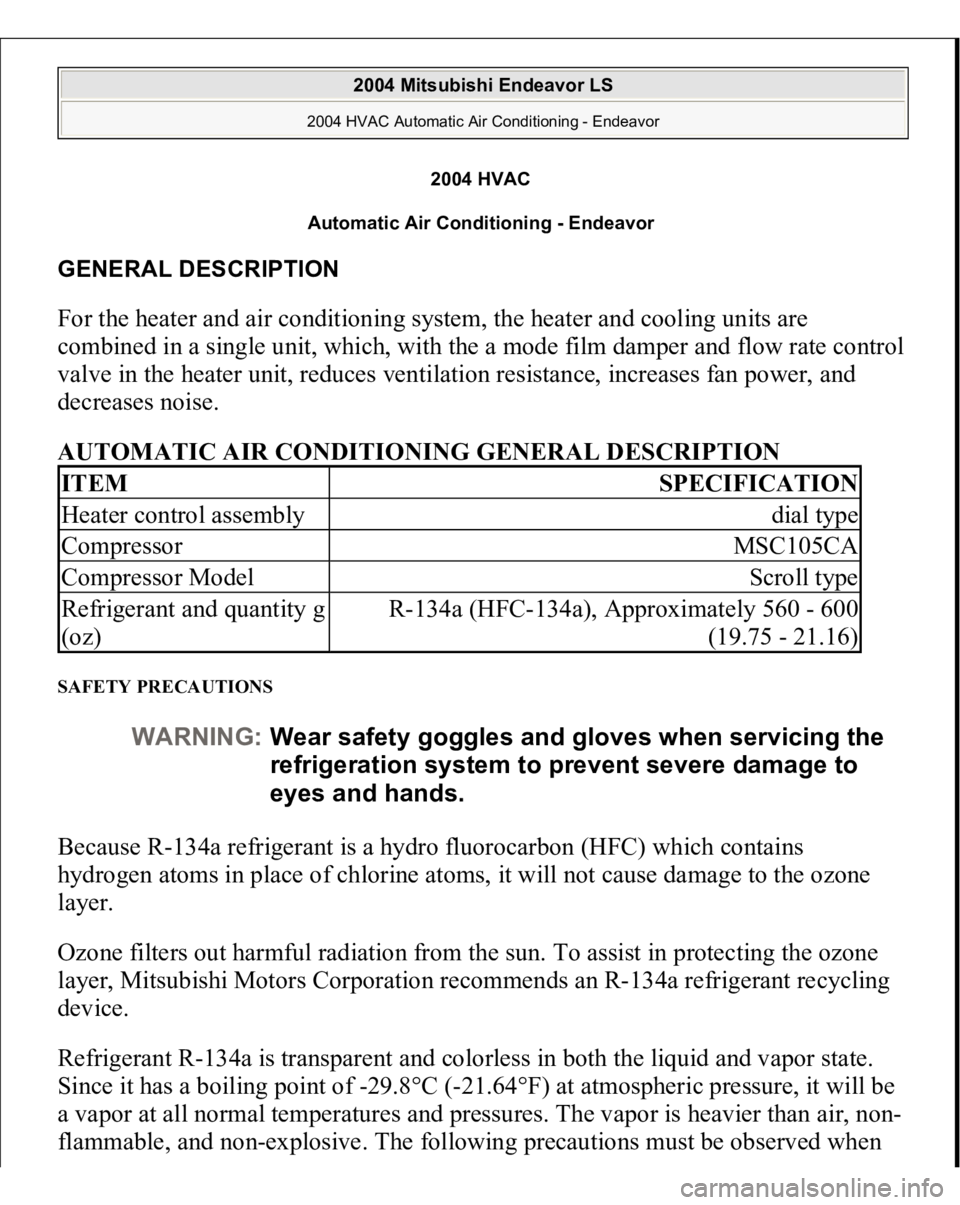
2004 HVAC
Automatic Air Conditioning - Endeavor
GENERAL DESCRIPTION For the heater and air conditioning system, the heater and cooling units are
combined in a single unit, which, with the a mode film damper and flow rate control
valve in the heater unit, reduces ventilation resistance, increases fan power, and
decreases noise. AUTOMATIC AIR CONDITIONING GENERAL DESCRIPTION
SAFETY PRECAUTIONS Because R-134a refrigerant is a hydro fluorocarbon (HFC) which contains
hydrogen atoms in place of chlorine atoms, it will not cause damage to the ozone
layer.
Ozone filters out harmful radiation from the sun. To assist in protecting the ozone
layer, Mitsubishi Motors Corporation recommends an R-134a refrigerant recycling
device.
Refrigerant R-134a is transparent and colorless in both the liquid and vapor state.
Since it has a boiling point of -29.8°C (-21.64°F) at atmospheric pressure, it will be
a vapor at all normal temperatures and pressures. The vapor is heavier than air, non-
flammable, and no
n-ex
plosive. The followin
g precautions must be observed when
ITEM
SPECIFICATION
Heater control assembly
dial type
Compressor
MSC105CA
Compressor Model
Scroll type
Refrigerant and quantity g
(oz)
R-134a (HFC-134a), Approximately 560 - 600
(19.75 - 21.16)
WARNING:Wear safety goggles and gloves when servicing the
refrigeration system to prevent severe damage to
eyes and hands.
2004 Mitsubishi Endeavor LS
2004 HVAC Automatic Air Conditioning - Endeavor
2004 Mitsubishi Endeavor LS
2004 HVAC Automatic Air Conditioning - Endeavor
Page 2420 of 3870
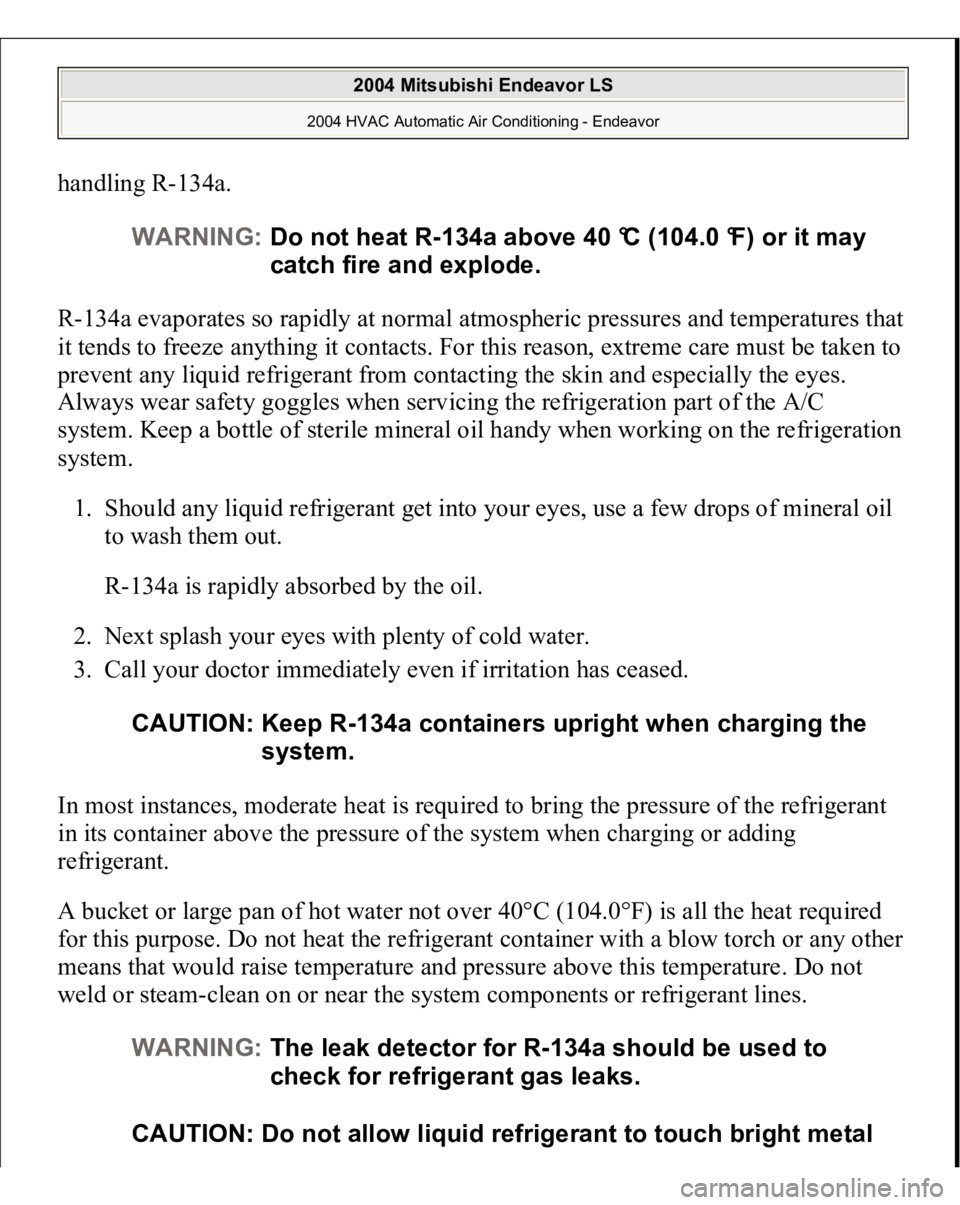
handling R-134a.
R-134a evaporates so rapidly at normal atmospheric pressures and temperatures that
it tends to freeze anything it contacts. For this reason, extreme care must be taken to
prevent any liquid refrigerant from contacting the skin and especially the eyes.
Always wear safety goggles when servicing the refrigeration part of the A/C
system. Keep a bottle of sterile mineral oil handy when working on the refrigeration
system.
1. Should any liquid refrigerant get into your eyes, use a few drops of mineral oil
to wash them out.
R-134a is rapidly absorbed by the oil.
2. Next splash your eyes with plenty of cold water.
3. Call your doctor immediately even if irritation has ceased.
In most instances, moderate heat is required to bring the pressure of the refrigerant
in its container above the pressure of the system when charging or adding
refrigerant.
A bucket or large pan of hot water not over 40°C (104.0°F) is all the heat required
for this purpose. Do not heat the refrigerant container with a blow torch or any other
means that would raise temperature and pressure above this temperature. Do not
weld or steam-clean on or near the system components or refrigerant lines.
WARNING:Do not heat R-134a above 40 °C (104.0 °F) or it may
catch fire and explode.
CAUTION: Keep R-134a containers upright when charging the
system.
WARNING:The leak detector for R-134a should be used to
check for refrigerant gas leaks.
CAUTION: Do not allow liquid refrigerant to touch bright metal
2004 Mitsubishi Endeavor LS
2004 HVAC Automatic Air Conditioning - Endeavor
Trending: valve cover, Compressor, torque, fluid, wheel, radio, air condition compressor
